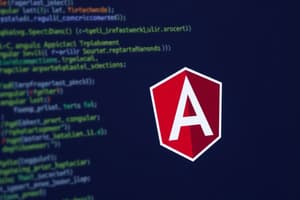Podcast
Questions and Answers
Что представляют собой компоненты Angular?
Что представляют собой компоненты Angular?
- JavaScript функции с CSS стилями
- TypeScript классы с HTML шаблонами (correct)
- JSON объекты с AJAX запросами
- HTML теги с TypeScript кодом
Какие возможности предоставляют директивы Angular?
Какие возможности предоставляют директивы Angular?
- Расширение функциональности встроенных элементов Angular (correct)
- Создание динамических шаблонов для компонентов
- Управление базой данных в приложении
- Автоматическая генерация кода приложения
Зачем используются формы Angular в приложениях?
Зачем используются формы Angular в приложениях?
- Для создания анимаций и специальных эффектов на странице
- Для управления файловой структурой приложения
- Для создания интерактивных форм и ввода данных пользователем (correct)
- Для автоматической генерации отчётов и аналитики
Что такое Angular services?
Что такое Angular services?
Какие компоненты являются строительными блоками Angular приложения?
Какие компоненты являются строительными блоками Angular приложения?
Что делают Angular services в отношении данных и поведения в приложении?
Что делают Angular services в отношении данных и поведения в приложении?
Что предоставляет Angular для создания современных веб-приложений?
Что предоставляет Angular для создания современных веб-приложений?
Какие основные компоненты Angular помогают создавать сильные и поддерживаемые приложения?
Какие основные компоненты Angular помогают создавать сильные и поддерживаемые приложения?
Что можно достичь путем понимания и использования сервисов и директив в Angular?
Что можно достичь путем понимания и использования сервисов и директив в Angular?
Какие возможности предоставляет Angular для удовлетворения потребностей и требований приложения?
Какие возможности предоставляет Angular для удовлетворения потребностей и требований приложения?
Flashcards are hidden until you start studying
Study Notes
Angular: A Comprehensive Guide
Angular is a popular framework for building modern web applications, offering a wide range of features and tools to streamline the development process. In this article, we will explore the main components of Angular, focusing on services, components, directives, routing, and forms.
Angular Services
Angular services are used to organize and manage code that performs specific functions for your application. When Angular creates a new instance of a component class, it determines which services or other dependencies that component needs by looking at the constructor. Services provide a way to share data and behavior across multiple components, making it easier to maintain a clean and organized codebase.
Angular Components
Angular components are the building blocks of an Angular application, allowing you to create reusable UI elements that can be shared across your application. Components consist of two parts: a TypeScript class and an HTML template with the component's markup. Standalone components provide a simplified way to build Angular applications, as they aim to streamline the authoring process and reduce code duplication.
Angular Directives
Angular directives are used to extend the functionality of Angular's built-in elements, allowing you to create custom behaviors and styles for your application. Directives typically appear within an element tag as attributes, either by name or as the target of an assignment or a binding. Angular applies directives at compile time, ensuring that the custom behaviors and styles are applied correctly to the elements they are applied to.
Angular Routing
Angular routing is a feature that enables navigation between different parts of your application, allowing you to define a navigation path among the different application states and view hierarchies. The Angular Router package provides a service that helps you set up routes and navigate between them, making it easier to structure your application's navigation and maintain a clean and organized codebase.
Angular Forms
Angular forms are used to create interactive forms in your application, allowing users to input data and interact with your application's data model. Angular provides built-in support for form validation, making it easier to ensure that user input meets specific requirements and standards. By using Angular forms, you can create a more interactive and responsive user experience, improving the overall usability of your application.
In conclusion, Angular is a powerful framework for building modern web applications, offering a wide range of features and tools to streamline the development process. By understanding and utilizing Angular's services, components, directives, routing, and forms, you can create robust and maintainable applications that meet your application's needs and requirements.
Studying That Suits You
Use AI to generate personalized quizzes and flashcards to suit your learning preferences.




